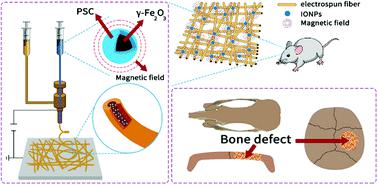当前位置:
X-MOL 学术
›
J. Mater. Chem. B
›
论文详情
Our official English website, www.x-mol.net, welcomes your
feedback! (Note: you will need to create a separate account there.)
Superparamagnetic core–shell electrospun scaffolds with sustained release of IONPs facilitating in vitro and in vivo bone regeneration
Journal of Materials Chemistry B ( IF 6.1 ) Pub Date : 2021-08-21 , DOI: 10.1039/d1tb01261d Shuying Hu 1 , Hanbang Chen 1 , Fang Zhou 1 , Jun Liu 1 , Yunzhu Qian 2 , Ke Hu 3 , Jia Yan 1 , Zhuxiao Gu 4 , Zhaobin Guo 5 , Feimin Zhang 1 , Ning Gu 6
Journal of Materials Chemistry B ( IF 6.1 ) Pub Date : 2021-08-21 , DOI: 10.1039/d1tb01261d Shuying Hu 1 , Hanbang Chen 1 , Fang Zhou 1 , Jun Liu 1 , Yunzhu Qian 2 , Ke Hu 3 , Jia Yan 1 , Zhuxiao Gu 4 , Zhaobin Guo 5 , Feimin Zhang 1 , Ning Gu 6
Affiliation

|
Bone tissue engineering (BTE) is a promising approach to recover insufficient bone in dental implantations. However, the clinical application of BTE scaffolds is limited by their low mechanical strength and lack of osteoinduction. In an attempt to circumvent these limitations and improve osteogenesis, we introduced magnetic iron oxide nanoparticles (IONPs) into a core–shell porous electrospun scaffold and evaluated their impact on the physical, mechanical, and biological properties of the scaffold. We used poly(lactic-co-glycolic acid)/polycaprolactone/beta-tricalcium phosphate (PPT) scaffolds with and without γ-Fe2O3 encapsulation, namely PPT–Fe scaffolds and PPT scaffolds, respectively. The γ-Fe2O3 used in the PPT–Fe scaffolds was coated with polyglucose sorbitol carboxymethylether and was biocompatible. Structurally, PPT–Fe scaffolds showed uniform iron distribution encapsulated within the resorbable PPT scaffolds, and these scaffolds supported sustainable iron release. Furthermore, compared with PPT scaffolds, PPT–Fe scaffolds showed significantly better physical and mechanical properties, including wettability, superparamagnetism, hardness, tensile strength, and elasticity modulus. In vitro tests of rat adipose-derived mesenchymal stem cells (rADSCs) seeded onto the scaffolds showed increased expression of integrin β1, alkaline phosphatase, and osteogenesis-related genes. In addition, enhanced in vivo bone regeneration was observed after implanting PPT–Fe scaffolds in rat calvarial bone defects. Thus, we can conclude that the incorporation of IONPs into porous scaffolds for long-term release can provide a new strategy for BTE scaffold optimization and is a promising approach that can offer enhanced osteogenic capacity in clinical applications.
中文翻译:

具有持续释放IONPs的超顺磁性核壳静电纺丝支架,促进体外和体内骨再生
骨组织工程 (BTE) 是一种很有前途的方法来恢复种植牙中骨量不足的情况。然而,BTE 支架的临床应用受到其低机械强度和缺乏骨诱导的限制。为了克服这些限制并改善成骨,我们将磁性氧化铁纳米颗粒 (IONP) 引入核壳多孔静电纺丝支架中,并评估它们对支架的物理、机械和生物学特性的影响。我们使用了有和没有γ-Fe 2 O 3封装的聚(乳酸-共-乙醇酸)/聚己内酯/β-磷酸三钙(PPT)支架,分别是PPT-Fe支架和PPT支架。γ-Fe 2 O 3用于 PPT-Fe 支架的涂层涂有聚葡萄糖山梨醇羧甲基醚,具有生物相容性。在结构上,PPT-Fe 支架显示出包裹在可吸收 PPT 支架内的均匀铁分布,这些支架支持可持续的铁释放。此外,与PPT支架相比,PPT-Fe支架表现出明显更好的物理和机械性能,包括润湿性、超顺磁性、硬度、拉伸强度和弹性模量。对植入支架上的大鼠脂肪来源的间充质干细胞 (rADSCs) 进行的体外试验显示,整合素 β1、碱性磷酸酶和成骨相关基因的表达增加。此外,体内增强在大鼠颅骨缺损中植入 PPT-Fe 支架后观察到骨再生。因此,我们可以得出结论,将 IONPs 掺入多孔支架中进行长期释放可以为 BTE 支架优化提供新的策略,并且是一种有前途的方法,可以在临床应用中提供增强的成骨能力。
更新日期:2021-09-08
中文翻译:

具有持续释放IONPs的超顺磁性核壳静电纺丝支架,促进体外和体内骨再生
骨组织工程 (BTE) 是一种很有前途的方法来恢复种植牙中骨量不足的情况。然而,BTE 支架的临床应用受到其低机械强度和缺乏骨诱导的限制。为了克服这些限制并改善成骨,我们将磁性氧化铁纳米颗粒 (IONP) 引入核壳多孔静电纺丝支架中,并评估它们对支架的物理、机械和生物学特性的影响。我们使用了有和没有γ-Fe 2 O 3封装的聚(乳酸-共-乙醇酸)/聚己内酯/β-磷酸三钙(PPT)支架,分别是PPT-Fe支架和PPT支架。γ-Fe 2 O 3用于 PPT-Fe 支架的涂层涂有聚葡萄糖山梨醇羧甲基醚,具有生物相容性。在结构上,PPT-Fe 支架显示出包裹在可吸收 PPT 支架内的均匀铁分布,这些支架支持可持续的铁释放。此外,与PPT支架相比,PPT-Fe支架表现出明显更好的物理和机械性能,包括润湿性、超顺磁性、硬度、拉伸强度和弹性模量。对植入支架上的大鼠脂肪来源的间充质干细胞 (rADSCs) 进行的体外试验显示,整合素 β1、碱性磷酸酶和成骨相关基因的表达增加。此外,体内增强在大鼠颅骨缺损中植入 PPT-Fe 支架后观察到骨再生。因此,我们可以得出结论,将 IONPs 掺入多孔支架中进行长期释放可以为 BTE 支架优化提供新的策略,并且是一种有前途的方法,可以在临床应用中提供增强的成骨能力。











































 京公网安备 11010802027423号
京公网安备 11010802027423号